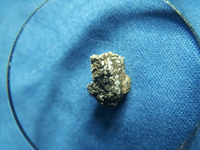B
BiggusDiggus
Guest
Found this with an AT Gold, solid hit in the 40's...not sure what it is..have other pieces that set the detector off with no visible signs of metal on exterior..smashed with hammer, and 2 interior pieces smooshed together? Could it be Gold or Silver ore?was thinking of trying to crush and melt....or bring for acid test...Any thoughts? HH


Upvote
0




